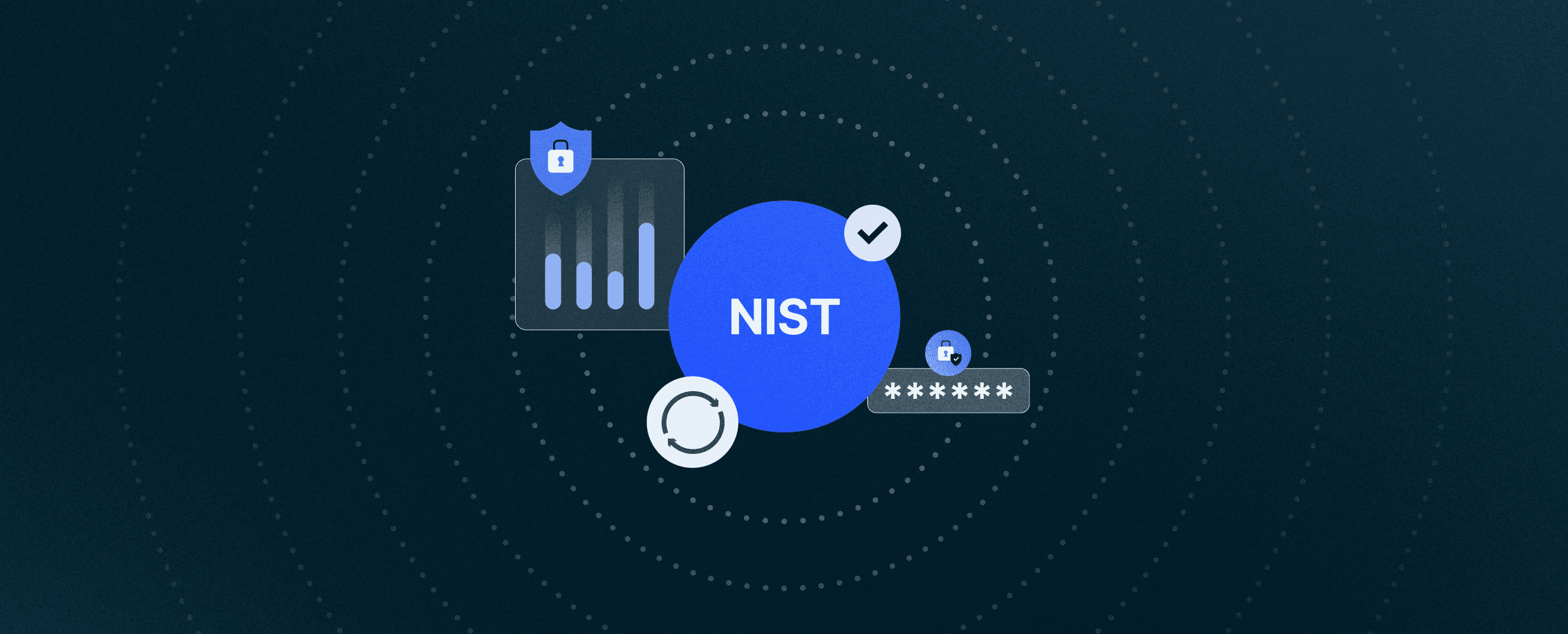The Complete Guide to NIST Password Guidelines (2025 Update)
Stay secure in 2025 with NIST’s updated password guidelines. Learn the latest best practices for strong, effective password policies.
Passwords are the first line of defense against unauthorized access to your systems, but outdated policies can do more harm than good. In August 2024, the National Institute of Standards and Technology (NIST) released updated guidelines for password security, shifting the focus from mandatory resets and complex character requirements to more practical, evidence-based practices. These changes reflect a growing understanding that longer passwords, real-time blocklists, and multi-factor authentication are more effective than rigid composition rules.
For startup and scaleup leaders, understanding these guidelines isn’t just about mitigating risk—it’s about aligning with best practices that streamline security and protect against evolving threats.
This guide breaks down the latest NIST password recommendations and shows you how to implement them across your organization to reduce the risk of credential-based attacks while maintaining compliance with frameworks like SOC 2 and ISO 27001.
Let’s dive into what’s new in NIST’s 2025 update and why it matters for your business.
New to NIST Compliance? Read our complete guide.
Why Password Security Still Matters
Weak passwords are one of the leading causes of data breaches worldwide. In 2024, 88% of basic web application attacks involved stolen credentials.
Despite advancements in cybersecurity tools, many organizations, especially startups, still rely on outdated, ineffective password practices, like frequent resets and overly complex requirements that users struggle to remember.
This often happens because startups prioritize rapid growth and product development over formal security policies. They adopt piecemeal solutions that don’t scale effectively, from reusing passwords across multiple platforms to implementing mandatory complexity rules that frustrate users and drive them to unsafe workarounds.
The results are weak, predictable passwords that are easily guessed or cracked, leaving systems vulnerable to unauthorized access and data theft. According to Verizon’s 2024 Data Breach Investigations Report, 31% of breaches involve stolen or weak credentials, highlighting the urgent need for better password security practices across all industries.
Transitioning to more secure, NIST-recommended password practices will reduce your risks and align your business with broader cybersecurity frameworks like SOC 2 and ISO 27001 to reinforce your overall security posture.
NIST Password Guidelines Overview
NIST’s password guidelines set a new standard for creating strong, user-friendly passwords that are easier to remember and harder to crack. In this section, we’ll cover the core recommendations from the NIST 2025 update, focusing on password length, allowable characters, and eliminating outdated composition rules.
Set a Strong Foundation for Password Creation
A strong password policy is the cornerstone of effective security. NIST’s 2025 guidelines recommend that organizations enforce a minimum password length of 8 characters, with a strong recommendation to extend this to at least 15 characters where feasible. While longer passwords are preferred, the focus is on memorability and convenience to prevent users from resorting to insecure workarounds, like writing passwords down or reusing the same password across multiple accounts.
Additionally, NIST advises against enforcing outdated composition rules that require specific character types, such as uppercase letters, numbers, or special characters. This change reflects evidence that complex rules often lead to predictable patterns or easy-to-guess modifications (e.g., “Password123!”), which attackers can easily exploit using common password-cracking techniques.
Instead, organizations should allow users to leverage all printable ASCII and Unicode characters. This provides flexibility and reduces the likelihood of predictable patterns.
Such an approach simplifies password creation while remaining aligned with broader security frameworks, which emphasize strong access control measures. For more guidance on implementing effective password policies, check out our resource on user access reviews.
Use Password Managers and Simplify Entry
NIST’s 2025 guidelines advocate for user-friendly authentication practices that prioritize both security and convenience. One of the most impactful ways to achieve this is by encouraging or enabling the use of password managers. These tools securely store complex passwords, which reduces the risk of password reuse and minimizes reliance on easily guessable phrases.
To further streamline the login experience, NIST recommends implementing a “show password” option during entry. This simple feature helps users confirm they’ve entered the correct password, preventing frustrating lockouts and unnecessary reset requests.
Additionally, the guidelines discourage outdated security measures such as password hints and knowledge-based authentication, like security questions. These methods are easily exploited through social engineering and do not provide sufficient protection against modern threats. Eliminating and replacing these features with more secure reset mechanisms, such as multi-factor authentication, strengthens overall account security.
Block Weak and Compromised Passwords
Even the most well-crafted password policies are ineffective if users can set weak or compromised passwords. NIST’s 2025 guidelines now strongly recommend implementing real-time blocklists that prevent the use of passwords previously exposed in data breaches or commonly used, easily guessed credentials. This shift from recommendation to requirement underscores the urgency of preventing predictable, weak passwords from entering your systems.
Organizations should implement password blocklists that prevent the use of commonly exploited passwords such as “123456,” “password,” or any variation of the company name. Additionally, integrating password-checking services that reference known data breach repositories can further reduce risk by alerting users when their chosen password has been compromised elsewhere.
For an added layer of security, companies can adopt adaptive authentication measures that adjust login requirements based on risk factors such as geolocation, device, or recent account activity. This strategy not only prevents unauthorized access but also aligns with broader risk management frameworks.
Stop Expiring Passwords Automatically
Traditional password policies have often mandated periodic resets, but NIST’s new guidelines take a more nuanced approach. Rather than enforcing periodic password changes, the focus is now on requiring resets only when there is clear evidence of compromise. This prevents unnecessary disruptions and minimizes the likelihood of users resorting to insecure, easy-to-remember passwords.
Organizations may consider reduced reset frequency for long, high-entropy passwords, but should always initiate resets when compromise is confirmed or strongly suspected.
When resets are necessary, organizations should implement secure, self-service password reset mechanisms that verify user identity before allowing changes. This ensures that only authorized individuals can initiate the reset process, mitigating the risk of account takeover.
Enable and Enforce Multi-Factor Authentication (MFA)
Multi-factor authentication (MFA) is a cornerstone of NIST’s 2025 guidelines for password security. As it requires users to verify their identities through two or more authentication factors, MFA significantly reduces the risk of unauthorized access (even if a password is compromised).
NIST recommends that organizations enforce MFA across all sensitive systems and accounts, especially those with privileged access. This involves using at least two of the following authentication methods:
Something you know: Passwords or PINs
Something you have: Hardware tokens or authenticator apps
Something you are: Biometric data, such as fingerprints or facial recognition
Additionally, NIST advises organizations to assess their MFA implementations regularly to ensure they align with evolving threats. Adaptive MFA can further strengthen security by adjusting authentication requirements based on contextual risk factors, such as login location or device.
Implementing MFA also supports broader compliance frameworks like SOC 2 and ISO 27001, both of which emphasize robust access controls.
Store Passwords Securely
Organizations are now required to store passwords using cryptographic hashing algorithms that are resistant to brute-force attacks and other forms of password cracking. This ensures that even if a database is compromised, the hashed passwords are much more difficult for attackers to decode.
NIST recommends salting and hashing passwords and using algorithms such as PBKDF2, Argon2, or bcrypt. These algorithms are specifically designed to slow down potential attackers by requiring extensive computational power to crack each password.
Additionally, NIST emphasizes the importance of regular audits of password storage systems to ensure they remain aligned with current cryptographic standards. Such a proactive approach mitigates the risk of data breaches caused by weak or outdated hashing methods.
Control Login Attempts and Detect Abuse
Organizations should implement automated mechanisms to limit the number of consecutive failed login attempts and temporarily lock accounts that exhibit suspicious activity.
NIST also recommends integrating real-time monitoring and alerting systems to identify patterns of malicious behavior, such as credential stuffing or brute-force attacks. These systems should flag unusual login attempts based on factors like IP address, location, and device type.
To further enhance security, organizations can deploy adaptive authentication measures that require additional verification when high-risk activity is detected. Examples include:
Sending a one-time passcode (OTP) to a verified email or phone number
Prompting biometric verification
Requiring reauthentication through an authenticator app
This multilayered strategy protects user accounts and, like all other guidelines, helps maintain compliance with frameworks like SOC 2 and ISO 27001, both of which recommend proactive threat detection and incident response.
What if a Password Gets Compromised?
Even with strong password policies in place, breaches can still happen. NIST’s 2025 guidelines outline key actions to take when a password is compromised, from initiating immediate resets to implementing continuous monitoring. Let’s review the essential steps that’ll help you minimize damage and prevent further unauthorized access.
Require Immediate Password Reset
When a password is compromised, immediate action is of the essence. NIST’s 2025 guidelines emphasize prompting users to change their passwords as soon as possible to prevent further unauthorized access.
The new password should be screened against breach corpora to ensure it hasn’t been exposed in previous data leaks. It must comply with current policy requirements, including length and uniqueness.
Avoid Reusing Knowledge-Based Verification
Traditional security questions are no longer considered secure for verifying a user’s identity during a password reset. NIST advises against using knowledge-based authentication due to its vulnerability to social engineering.
Instead, organizations should verify identity through a secure channel the user already controls, such as a verified email address, SMS (with caution due to SIM swapping risks), or a trusted authenticator app.
Check for Reuse and Broader Exposure
During the reset process, dynamic blocklists should be enforced to prevent users from reusing compromised or similar passwords. If there is evidence that the same compromised credentials may be used across multiple accounts or systems, broader alerts or resets should be initiated to mitigate potential cascading breaches.
Log the Incident and Monitor the Account
Accounts associated with compromised passwords should be flagged for additional monitoring. NIST recommends enhanced scrutiny of login patterns, device fingerprints, and geolocation data to detect potential follow-up attacks.
All activity related to the compromised account should be logged for compliance and forensic follow-up. If the account has access to regulated systems or sensitive data, security and compliance teams should be notified to assess further risk and initiate containment measures.
Secure Passwords Are Just the Start—Automate the Rest with Drata
Implementing strong password policies is an important first step, but it’s not enough to protect you against evolving threats. Drata’s automated Trust Management platform provides continuous monitoring and control enforcement across your tech stack, ensuring that password policies are consistently applied and updated in line with the latest NIST guidelines.
Drata’s capabilities extend beyond password management to integrate with your existing systems to streamline access reviews, detect anomalies, and flag potential security gaps. With features like automated evidence collection and customizable risk assessments, Drata helps organizations stay compliant with frameworks like SOC 2 and ISO 27001 while reducing the manual workload for security teams.
NIST Password Guidelines Frequently Asked Questions (FAQs)
Below, we cover the most common questions about the latest NIST password guidelines.
Do I Have to Follow NIST to be SOC 2 Compliant?
No, NIST guidelines are not mandatory for SOC 2 compliance. However, many organizations align with NIST best practices because they provide comprehensive, up-to-date security controls that complement SOC 2 requirements. Implementing NIST password guidelines can strengthen your overall security posture and demonstrate a proactive approach to risk management.
What’s the Difference Between NIST SP 800-63b and SP 800-63-4?
NIST Special Publication 800-63b focuses specifically on digital identity guidelines, including password creation, authentication, and recovery processes. SP 800-63-4, currently in drafts, is a broader update that addresses emerging cybersecurity threats and emphasizes continuous risk assessment and incident response, integrating guidelines from multiple NIST publications.
Why Did NIST Drop Password Expiration Rules?
NIST eliminated mandatory password expiration rules because they often lead to weaker security practices, such as predictable patterns or password reuse. Instead, the guidelines focus on requiring password changes only when there is evidence of compromise and encouraging longer, more complex passwords that are less likely to be guessed or cracked.
Can We Still Require Password Complexity?
While NIST no longer mandates specific composition rules (like uppercase, numbers, or symbols), organizations can still enforce them if they believe it is necessary. However, NIST recommends prioritizing length requirements over complexity and using blocklists to prevent weak or compromised passwords.
How Often Should We Review Our Password Policies?
NIST recommends reviewing password policies regularly to ensure they align with the latest best practices to defend against cybersecurity threats. At a minimum, organizations should reassess their policies annually or whenever significant security incidents occur.
Automated monitoring solutions like Drata can help streamline this process by providing continuous control enforcement and regular policy assessments.





